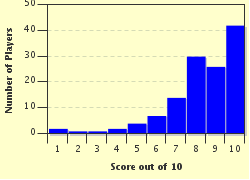Quiz Answer Key and Fun Facts
1. My five mates and I are on the way to a football match. There is new mall opened in our part of the city so we Have decided to find a Japanese restaurant afterwards to have a meal of Sushi.
Brisbane, where we live, like most Australian capital cities, is one of the most multi-cultural cites in the world so we are confident we will find at least one Japanese restaurant in the mall.
However we are at the football and we need lunch. The food in the stadium is distinctly Australian and we resist the traditional seven course Aussie meal for something a bit lighter. We decide each of us will order something our American mate, Chip does not understand. He thought we said, "Poyenpees". What have we decided to order?
2. After the match, won by the Brisbane Broncos naturally, we start to walk back to the car to take us back to our side of town to the mall. Jean-Paul drove because he didn't drink any alcohol, as he couldn't find any wine at the footy. Outside the stadium, Tiny (so called because he's a big guy) didn't think he would make it through the 30 minute drive across town. He found a food van, "Anatolia Kebabavan" so he got himself a pita bread sandwich filled with lamb, onions, tomatoes, lettuce and tahini sauce. What country is the Doner Kebab from?
3. On our way to the mall we pass a sleek low-slung stainless steel building with a big gaudy orange neon sign on top, proudly proclaiming, "Diner" . There was even a T-Bird parked out the front. Chip, probably feeling a bit homesick, begged us to stop. We decided a snack would do no harm. Which food from the options below would we *NOT* have ordered?
4. We arrive at the new mall. It is huge. The six of us decide to split into three groups to find a Japanese restaurant that makes sushi. Chip and I find a restaurant that sells Pho Soup and Rice Paper Rolls. What kind of restaurant have we found?
5. Tiny and Charles meet back at the designated spot without finding a Japanese restaurant although Tiny is munching his way through a burrito and what looks like the remnants of a quesadilla. What type of restaurant did they find?
6. Spit and Jean-Paul are late meeting us at the rendezvous. "What took you so long?" ask I, notoriously short of temper. "Sorry Blue", says Jean-Paul, (of course I have red hair), "but we looked everywhere, we knew we would be late but we bought you some patatas bravas as a peace offering" I did not get to sample the dish as Tiny grabbed it from Jean-Paul and began digging into the patatas bravas. I didn't taste but they looked good. What type of restaurant did Jean-Paul locate?
7. Spit gets a text from his Mum saying she had just done a heap of cooking and he was welcome to bring all of us over for a meal. Now Spit is Polish (but you already knew that from his name) so what sort of meal could we expect at Spit's place?
8. After a huge meal, Spit's Mum is pleased we all are sated, Spit's sister, Aleksandra teaches cooking at a local community college. She brings out dessert: Individual Crème Brulées , Profiteroles and a Tarte Tatin. What country's cuisine is she teaching at the moment?
9. After dessert, coffee appears and there is a Fortune Cookie in the saucer of each cup. Fortune Cookies are not Chinese in origin. In fact their exact origin is unclear. However it is known where they first became popular. In what part of the world did Fortune Cookies first become popular?
10. My fortune cookie tells me. "You must not end unfinished quests". I look at Tiny, "You up for this?", knowing my question is rhetorical. (All the others are half-asleep from all the food they have consumed). We go back to the mall after thanking our host profusely. We find a section of the mall we previously missed. There are two restaurants next to each other. Tiny reads off the menu posted outside one of them, "I've got Gimbap and Kimchi". I read off the menu of the adjacent restaurant's menu. "I've got California Roll and Miso Soup". Who found a Japanese restaurant?
Source: Author
1nn1
This quiz was reviewed by FunTrivia editor
WesleyCrusher before going online.
Any errors found in FunTrivia content are routinely corrected through our feedback system.

